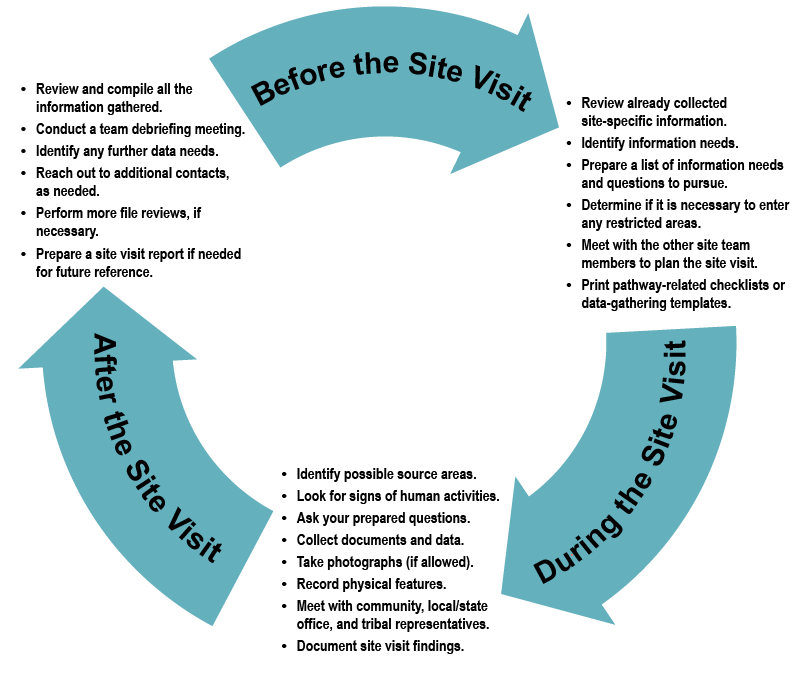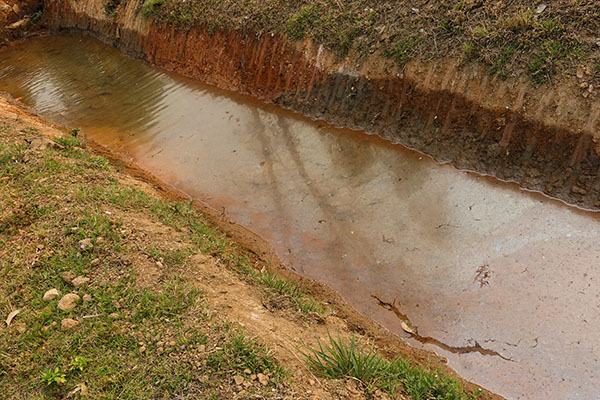The Site Visit
Learn the key activities you should take before, during, and after the site visit.
A site visit is essential for gathering relevant site information. It helps you to:
- Meet site representatives, local officials, tribal organizations, community members, and other stakeholders.
- Establish contacts to facilitate the collection of relevant information.
- Tour the site to determine activities and possible ways that community members might be exposed to contaminants.
- Obtain first-hand knowledge of current site conditions.
- Confirm previously obtained site information.
See the key activities to take before, after, and during the site visit in the diagram below.
Key Activities Before, During, and After the Site Visit

For a detailed description of the image, click here.
A small ATSDR site team will conduct the site visit. While the group can vary depending on site issues, it typically includes the health assessor, the regional representative, and a health communications specialist. Coordination among these individuals is critical for a successful site visit.
To prepare for your site visit, you will:
- Review any information you collected, such as background information (including maps), community health concerns, relevant environmental and health outcome data, and demographics, noting what site-related information is already publicly available, such as EPA’s Toxic Release Inventory (TRI) data and site-related reports.
- Prepare a list of information needs and questions to pursue during your site visit.
- Determine if you will need to enter any restricted areas (e.g., “hot zones”). If so, make sure site visit participants’ health and safety training is up to date and confirm they have completed all required approval forms (e.g., safety check-off list, site health and safety plan, travel requisitions).

The ATSDR site team works together prior to the site visit to define each person’s roles and responsibilities. The team will consist of different ATSDR staff, depending on the particular needs of each site.
- Meet with the other site visit participants to plan the site visit. Work together to do the following:
- Coordinate with the appropriate site or facility representatives to schedule site visit activities.
- Brief each contact about the purpose of the visit, and send an email confirmation of the meeting dates, times, and places.
- Determine the role and responsibilities for each site team member to carry out during the site visit.
- Determine the type of meeting best suited for the community engagement, and arrange for the meeting to be held during the site visit.
- Invite representatives of relevant agencies (EPA, state and local health and environmental departments, tribes) to appropriate meetings or visits.
- Develop informational materials such as press releases and fact sheets.
The site visit typically involves touring the site, meeting with community members and other contacts, obtaining relevant documents, and gathering additional information.
A tour of the site and its surrounding area is an invaluable part of all site visits and a critical component of your information collection activities (see example in text box). Always use professional judgement to stay out of danger. All members of the ATSDR site team are responsible for adhering to ATSDR and other applicable health and safety requirements.
While touring the site, be sure to go through your site information checklist [PDF – 853 KB] and keep the following points in mind:
- Identify as much as possible any contamination source areas and their locations/proximity to:
- Private wells.
- Physical hazards.
- Warning signs or fences.
- Potential exposure points.
- Approximate distances to places where people live and work.
- Look for signs of human activities such as:
- Presence of toys, indicating children are playing at or close to the site.
- Location of schools, childcare centers, playgrounds, retirement centers, or health care facilities near the site.
- Recreational or subsistence uses of nearby natural resources.
- Ask the questions you prepared prior to the visit.
- Collect any relevant documents and data sets.
- Take photographs during the site visit (with permission) to record possible exposure clues such as:
- Physical hazards.
- Any visible releases or signs of contamination.
- Evidence of trespassing.
- Areas where contaminants may have traveled off site (e.g., surface water runoff).
- Areas where community contact and exposures to contaminants might occur.
- Current and previous property uses.
- Monitors or pressure gauges for vapor intrusion mitigation systems.
- Use a map or geocoding to record the location and direction of physical features.
- Meet with community members, local and state officials, and tribal representatives as arranged prior to the visit.
Tip: Come to these meetings prepared with specific questions and information requests, working closely with your health communication specialist. - Obtain any available publicly-reported odor or incident complaints if collected by communities, facilities, or local governments. [Note: Health assessors can refer to ATSDR resources to help address environmental odors in communities.]
- Document the findings of your site visit in detailed notes. Be sure to:
Examining the site area for signs of children playing is one of the more important reasons for a site scoping visit. At one petitioned site, a health assessor observed children’s toys in a drainage ditch connected to a wood treatment lagoon. Subsequent discussions with parents revealed several local children reported skin rashes and other problems after playing in the drainage ditch where sampling revealed high levels of polycyclic aromatic hydrocarbons in soil and water.

ATSDR broadly defines the community associated with a site as the entire population living on and around the site. Community members and community-based organizations are excellent sources of information about the site and community health concerns, including:
- Site-specific issues.
- Nature of the concerns.
- Local behavioral patterns that may influence exposures.
- Degree to which the community is involved.
Tip: Conduct the site tour before meeting with the community so that you can better understand community references and locations they may mention.
Remember: Before reaching out to any community members directly, you need to have a firm understanding of ATSDR’s process for engaging the community. While initial contact with community members and others could happen during the site visit, working with stakeholders is a process that will likely continue throughout the PHA process.
Community Contacts
Working with the community engagement specialist, health educator, and regional representative, you can typically identify a few key community contacts (individuals and organizations) by reading through government site files or talking with staff from different government agencies. Some of the individuals and community groups that you might want to contact include:
- Individual site petitioners (if any) and local residents, particularly community leaders
- Site-specific advisory boards
- Tribal organizations/leaders
- Faith-based organizations
- Local medical society and other healthcare providers
- Fishing, hunting, agricultural, conservation, and industrial organizations
- Media outlets and social media influencers
- Community organizations
- Local community environmental groups
- Staff at universities or other area academic institutions
- School principals and school nurses
- Labor unions
- Staff of local institutions and facilities near the site (e.g., childcare centers, prisons)

CDC/Christine Pearson; photographer: Greg Knobloch
Initial community contacts can often suggest additional people in the community to contact that you might not have been aware of otherwise.
Request meetings with some of these community members during your site visit to learn more about community concerns. Community contacts often can provide you with valuable information about the site, ways to obtain site data, the level of community interest, and the best strategies for interacting with the community. You can begin determining the extent of concern within a community by noting the nature and number of questions that residents ask. Be sure to work with health communication specialists to facilitate your interactions with the community.
You may also want to review local/community newspapers, including online archives, and local social media sources to identify historical information and health concerns. These sources might fill some information gaps in available site records.
Site Representatives
It is very important to develop an open relationship with site representatives, including site owners, PRPs, and their contractors. Brief all site representatives on ATSDR’s role to gain their cooperation in obtaining needed site information. It is important that you begin to manage expectations from the initial contact with all parties. Be sure to explain 1) the PHA process and possible outcomes, 2) what the next steps are, and 3) how the site team will keep community members and stakeholders informed of the site team’s actions and expected timelines.
At federal facilities or other large industrial facilities, possible contacts include:
- Representatives of the public affairs office
- Occupational medicine, industrial hygiene, and public health professionals
- Civil engineering and/or water department staff
- Natural resources and pest management staff
- Facility environmental engineers or remedial program managers and staff representing other environmental programs
- Housing office staff
- Historians
- Individuals responsible for environmental or public health cases or issues
Remember: At federal facilities, coordination with a federal agency’s principal point of contact is typically required.
After the Site Visit
After conducting the site visit, you need to:
- Review and compile all the information gathered.
- Conduct a debriefing meeting to evaluate information obtained by all site visit participants to identify lessons learned and begin developing site priorities and an action plan.
- Identify any further data needs.
- Reach out to additional contacts, as needed.
- Perform more file reviews, if necessary.
- Prepare a site visit report for future reference, if deemed necessary, where you:
- List all the people contacted during the trip.
- Summarize each meeting and its outcome.
- Describe any environmental monitoring conducted.
- Summarize key site issues, important observations, and conclusions.
- Identify remaining data gaps and other recommended actions.
- Maintain communications with community members and stakeholders.